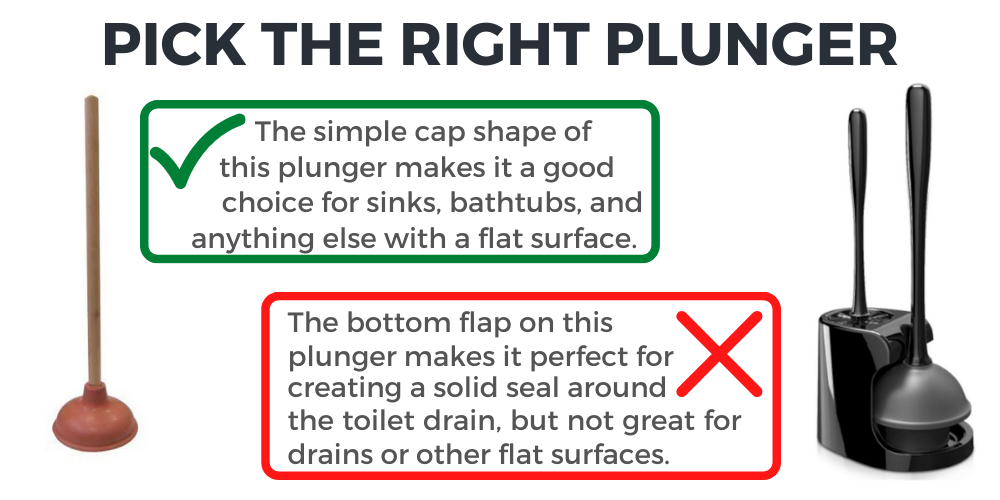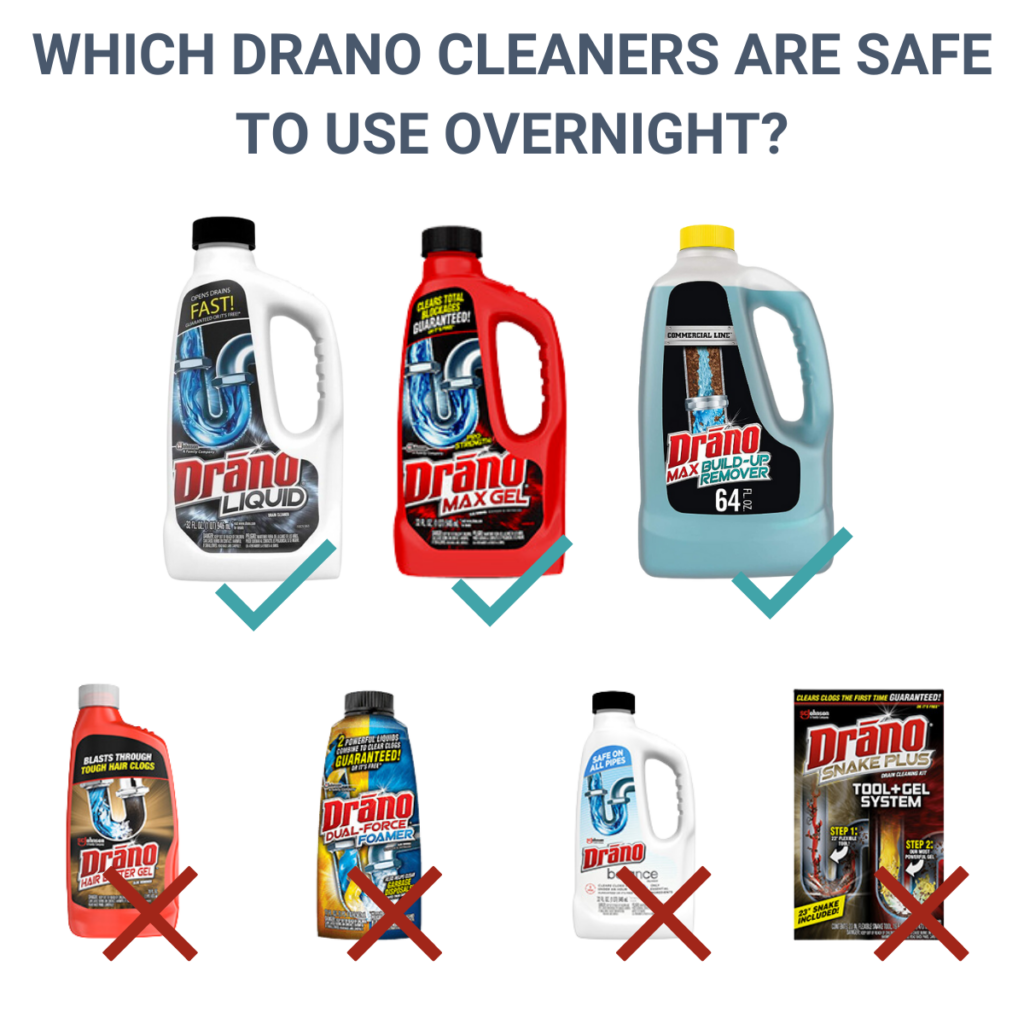Can You Leave Drano Overnight (These Three Won’t Damage Your Pipes)
When it comes to removing stubborn and large clogs, nothing beats Drano. This household reagent has powerful clog decomposing and dislodging power and generally works in minutes. But can you leave Drano overnight?
Avoid leaving Drano in your pipes overnight as the active ingredients can cause damage to your pipes or septic system. Drano should be left to work for 15-30 minutes, depending on the manufacturer’s directions and the severity of the clog, then flushed with hot water. If Drano doesn’t unclog the drain, try a baking soda and vinegar solution.
Keep reading to learn all about Drano, how it works, and why you shouldn’t leave it overnight – plus what to do if it’s stuck in the pipes!
What’s a Drano and how does it work?
Like many household items – think Band-aids and Kleenex – Drano is a brand-name product that has become synonymous with its general category. In this case, Drano is a drain cleaner and clog remover.
Drano is a popular brand of drain cleaner that specializes in unclogging even the toughest clogs without damaging your pipes or the delicate chemical balance of your septic system. Or at least that’s what it claims.

In reality, the cleaner, which is composed of bleach (sodium hypochlorite), lye (sodium hydroxide), aluminum, sodium nitrate, and sodium chloride can do as much damage to your plumbing as the clog itself.
When poured into a clogged drain, Drano creates a chemical reaction that decomposes and loosens the clog. Drano’s ingredients create a nearly-boiling temperature that hastens the decomposition of the clog.
Overall, you have to allow Drano to act for 15-30 minutes, but some homeowners are tempted to leave Drano overnight, and that’s where the risk comes in.
Can you leave Drano overnight, And if not, why?
Generally, Drano acts in 15-30 minutes, which means you don’t have to leave it in your drain overnight. While doing so may clear the stubbornest clog, it can be dangerous to your plumbing work and personal health.
The risks associated with leaving Drano to act overnight include:
- Pipe damage
- Septic system damage
- Healthy and safety risks
- Pungent smell
Let’s take a look at each of these risks in more detail.
1. Pipe damage
Remember, Drano works by creating a nearly-boiling temperature that has decomposition properties.
The extreme temperature can be too much for your wastewater pipes to handle. The drainage pipes may corrode, weaken, or even break over time and eventually fail in the long run.
For that reason, it is not ok to leave Drano overnight.
2. Septic system damage
There are two primary places waste goes after it leaves your home: the municipal sewer, or your septic system.
The septic tank has both good and bad bacteria. Unfortunately, Drano doesn’t know how to discriminate. It kills them both, rendering your septic tank less effective.
Without the good bacteria, more extensive blockages may likely occur, which could be much easier to fix.
3. Health and safety risks
Drano’s corrosive power makes it harsh on your skin. If the corrosive chemical comes into contact with any part of your body, especially when left for too long, it could cause burns. The same chemical releases fumes that can be equally dangerous.
The fumes from Drano can damage your lungs if you’re exposed to it for too long.
Not only should you not leave Drano overnight, you should only use it in a well-ventilated location.
4. Pungent smell
Drano is not just toxic, but it also has a displeasing smell.
The chemical reaction of its ingredients releases an odorous smell, which can make your home unlivable for some time – or longer, if left overnight.
Luckily, the problem is fixable by:
- Covering your face when working with Drano
- Blotting up Drano remnants with a paper towel or soft cloth
- Pouring lemon juice or vinegar solution down the drain to neutralize the smell
- Heavily rinsing the drain with water
- Opening up the doors and windows to encourage natural ventilation
What happens if you leave Drano overnight?
Drano should not be left in your pipes or clogged drain overnight.
Its active ingredients reach to create a nearly-boiling mixture, which can damage the pipe and septic system. That, in the long run, could lead to expensive plumbing or a much more serious clog.
Besides, it also releases an unbearable pungent smell.
Can Drano make a clog worse?
Drano is a clog remover, but it can actually make the problem worse if used improperly.
Drano can make a clog worse if you leave it to act for longer than recommended, and it ends up corroding the pipes. Also, it may kill the good bacteria, rendering your septic tank less effective.
For that reason, allow Drano to only work for 15-30 minutes before flushing with hot water.
How long can you leave Drano in the drain?
It is advisable only to leave Drano to act for 15-30 minutes. Drano’s active ingredients can corrode your pipe and damage your septic tank if you go beyond that. Moreover, it poses safety risks to you and your kids.
Can Drano damage pipes if left too long?
Drano can damage pipes if it sits in the lines for long hours. That’s because Drano has corrosive properties. For that reason, it’s advisable only to allow Drano to act for 15-30 minutes before rinsing it off by flushing.
What happens if Drano doesn’t go down?
While it’s not common, sometimes Drano doesn’t get the job done. In that case, what should you do?
If the drain is still clogged after using Drano, you’ll need to take another approach. First, use a plunger to try and dislodge the clog. If that doesn’t work, pour a mixture of vinegar and baking soda down the drain.
When plunging the clogged drain, ensure that you’re using the correct plunger (this one is for drains – don’t use this one, it’s for toilets!) and that you have a tight seal. If this is done improperly, you risk suctioning Drano back up and splattering it on yourself.

Can you use Drano overnight?
According to the Drano website, the brand has six formulations that are designed to break down and eliminate bathroom clogs. Of these, are any of them safe to use overnight?

According to Drano, only Drano Max Gel, Drano Liquid Drain Cleaner, and Drano Max Build-Up Remover are safe for use overnight.
Drano Hair Buster Gel, Drano Snake Plus Tool + Gel System, Drano Dual-Force Foamer, and Drano Balance are all appropriate for cleaning clogged bathroom drains; however, they cannot be left overnight.
Can you leave Drano Max Gel overnight?
While plumbers generally advise against using any drain cleaners overnight, some products contain additives that are meant to protect your pipes from corrosion.
Drano claims that Drano Max Gel is good for use in a variety of drains, including bathroom sinks, shower drains, and garbage disposals. It cuts through standing water to reach the clog and starts working in as little as 15 minutes. It is also formulated with an ingredient that should protect pipes from corrosion and, as such, can be left in drains overnight.
The brand claims this is the top-selling drain cleaner on the market based on Nielson reports, presumably because of these very claims. Plumbers would still urge you to use caution when leaving any chemicals sitting in your pipes, but it’s probably safe to leave this one overnight – if you can handle the smell.
What happens if Drano Max Gel doesn’t work?
If Drano Max Gel fails to work, which is quite unlikely, consider using household reagents.
You can pour salt water or a mixture of vinegar and baking soda and follow them up with hot water rinsing after 15-30 minutes of acting
Can you leave Drano Liquid Drain Cleaner overnight?
When your significant other tells you to pick up “Drano” to fix the clog in the bathroom, chances are you’re coming home with the white bottle. It’s the classic. It’s cheap. It’s exactly what you need for a slow drain.
Drano claims that Drano Liquid Drain Cleaner is good for use in a variety of drains, including bathroom sinks, shower drains, and garbage disposals. It doesn’t contain phosphate, meaning it is safe for rivers, lakes, and – perhaps most importantly to you – your septic tank. It is also formulated with an ingredient that should protect pipes from corrosion and, as such, can be left in drains overnight.
If you’ve got a tough clog, it’s probably worth letting this cleaner sit overnight to do its work.
Can you leave Drano Max Build-Up Remover overnight?
Only one of Drano’s unclogging lineup claims to be safe for use if your toilet is clogged.
Drano claims that Drano Max Build-Up Remover is good for use in a variety of drains, including bathroom sinks, shower drains, and even toilets. It helps remove buildup without harming your pipes. It is also formulated with natural enzymes and can be left overnight.
It may not be the best for unclogging a backed-up drain, but it’s worth keeping around to avoid a problem down the line!
Can you leave Drano Hair Buster Gel overnight?
As unpleasant as it may be to think about, bathroom sink and shower drains often start draining slowly because of thick, matted hair buildup in the pipes.
The Drano Hair Buster Gel should not be left in drains overnight. The chemicals that are used to quickly break down hairy clogs will also cause damage to your pipes if left for longer than the recommended time.
Drano claims this cleaner starts working in as little as 7 minutes, but you may need to leave it for as much as 30 minutes if you have a particularly tough clog.
Is Drano safe for shower drains? Find out what precautions you need to take!
Can you leave Drano Dual-Force Foamer Clog Remover overnight?
Drano Dual-Force Foamer Clog Remover is perfect for cleaning garbage disposals, but it can also be great for removing built-up soap residue from your bathroom drains.
The Drano Dual-Force Clog Remover should not be left in drains overnight. When the two chemicals mix, they create a foam that fills the pipe and dissolves any built-up gunk.
While this cleaner claims to be safe for both pipes and septic systems, you shouldn’t leave it overnight as that broken-down gunk could create a bigger clog if not promptly flushed away by hot water.
Can you leave Drano Balance Clog Remover overnight?
If you’re looking for a (slightly) more natural drain cleaner, Drano offers one that walks the line between chemical cleanup and safe for the environment.
The Drano Balance Clog Remover should not be left in drains overnight. It claims to be made with only the most necessary ingredients, meaning it won’t burn you if you come into contact with it, it’s safe for all pipes, and it doesn’t have the same harsh smell as other drain cleaners.
Unfortunately, many reviewers have noted that this product doesn’t work as well as some of the other Drano cleaners.
Can you leave Drano Snake Plus Tool + Gel System overnight?
If you’re looking at a bad clog, it’s time to bring in the big guns. Most of us don’t keep a plumbing augur around the house in case a drain backs up, but that’s where this product comes in.
The Drano Snake Plus Tool + Gel System should not be left in drains overnight. Use the snake tool to loosen the clog before following it with the Drano Pro Concentrate Gel.
While this product claims to be safe for all pipes, I don’t recommend leaving it overnight.
Should you buy Drano?
You are probably asking, ‘given Drano’s health and safety risks, is it worth buying?’
Assuming you’re not planning on leaving it overnight (unless directed) and you won’t be staying in the bathroom room with it, Drano is a good choice for unclogging your bathroom drain.
Some advantages of buying from the Drano brand are:
- Powerful action – Drano’s active ingredients create a nearly-boiling temperature that easily dislodges large and stubborn clogs in 15-30 minutes. In general, Drano is powerful against hair, grease, and food clog.
- Easy to use – You only need to pour Drano into the clogged drain and allow it to sit for 15-30 minutes before flushing. That’s how easy it is to use it.
- Not all Drano products are damaging – Some Drano products contain special ingredients that prevent pipe corrosion. In such cases, you won’t have to worry about your pipes weakening. Also, not all can damage your septic tank.
If you’re planning on leaving your drain cleaner overnight, I recommend picking up one of these:
These Drano reagents are effective against large and stubborn clogs and are generally safe on metal and PVC pipes and even the septic system. They are a good choice for all household drains.
Why do plumbers hate Drano?
Most plumbers hate Drano because of its harsh chemicals that damage the pipes and septic tanks following prolonged exposure.
Moreover, Drano has a pungent smell and is generally displeasing to work with for long hours.
What to do when Drano doesn’t work? (Drano alternatives)
While most Drano products can clear a clog in 15-30 minutes, there is no guarantee that it’ll work, more so when you only use it briefly. If you’re still staring down a bad clog, it may be tempting to try again, but don’t send chemical cleaner after chemical cleaner down your drain!
If Drano doesn’t work, employ one of these more natural methods to try and further loosen the clog:
- Baking soda and vinegar
- Salt
Let’s see exactly how these options work.
Option 1 – Baking soda + vinegar solution
You can dislodge large clogs with a mixture of baking soda and vinegar. The two agents combine in a chemical reaction to effectively loosen and decompose the clog.
To unclog a drain using baking soda and vinegar:
- Drain the clogged pipe (remove as much as possible).
- Mix baking soda and vinegar at a ratio of 1:2 and then pour it into the drain. In most cases, this will be 1 cup of baking soda to 2 cups of vinegar.
- Watch for bubbling as that indicates the mixture is working.
- Cover the drain and leave the solution to work for 15 minutes.
- When the bubbling stops, uncover the drain and pour hot water into the drain.
Never pour boiling water into PVC pipes as hot water can melt them.
Did you know you can also dissolve toilet baking using vinegar and baking soda?
Option 2 – Salt solution
Salt has clog-dissolving properties, though not as powerful as the vinegar-baking soda mixture. As a result, a mix of salt and water typically works on less extensive clogs, especially on sink drains.
To unclog a drain using salt:
- Mix a cup of salt with 8 liters of water and make a solution.
- Pour the solution into the clogged drain and allow it to act for 15 minutes.
- Pour boiling water down your drain.
Note that this method should not be used on PVC pipes as the boiling water will damage them.
Final thoughts
Popular wisdom (and most professional plumbers) say you should never leave drain cleaners overnight.
However, Drano claims that three of its popular drain cleaners are safe for overnight use:
- Drano Liquid Drain Cleaner
- Drano Max Gel
- Drano Max Build-Up Remover
All other Drano products should be flushed thoroughly after being allowed to sit for 15-30 minutes. Overexposure to these chemicals can lead to overheating, corrosion, and severe damage to your drainage system.
Let Us Know How We’re Doing!
Did this expertly prepared resource answer your question?
Do you have another question about home maintenance, home improvement projects, home appliance repair, or something else?
Get more information, send in questions and keep the discussion going by contacting the I’ll Just Fix It Myself company customer service team at at 1-800-928-1490 or Email us at [email protected]
